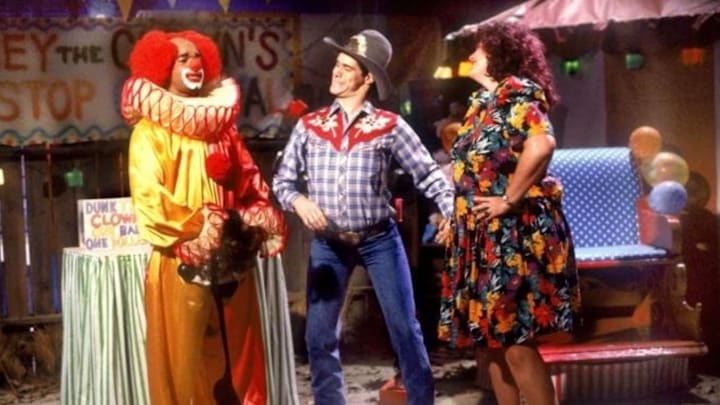In Living Color, a popular series co-created by Keenen Ivory Wayans and Damon Wayans, is often credited with revitalizing sketch comedy and amplifying Black voices on broadcast television. In addition to introducing many Wayans family members to the world, the series—which ran from 1990 to 1994—gave audiences some of their earliest glimpses of Jim Carrey, Jamie Foxx, and Jennifer Lopez.
One lesser-known but still significant fact: It also helped birth the modern Super Bowl Halftime Show.
Halftime Bathroom Break
In the 1980s and into the 1990s, the mid-game spectacles for the Super Bowl were little more than filler—something to occupy audiences as white noise while they replenished snacks or used the bathroom. A 1988 show featured people Jazzercising; in 1989, a magician dressed as Elvis Presley (“Elvis Presto”) performed what was billed as the world’s largest card trick, a confusing gimmick that was further burdened by a shortage of Coca-Cola-provided 3D glasses; in 1990, actors dressed as characters from the Peanuts comic strip cavorted across the field.

The banality of these productions wasn’t lost on Fox, which in the early 1990s was still attempting to establish itself as the fourth major network. Thanks to The Simpsons, Married…With Children, and In Living Color, it was successful at being a broadcast disruptor, courting attention with counterculture programming.
In 1991, Fox’s then-president Jamie Kellner decided to take it to another level. According to Homey Don’t Play That!: The Story of In Living Color and the Black Comedy Revolution, author David Peisner’s 2018 account of the show’s history, Kellner believed his network could capitalize on the Super Bowl even though CBS had the rights to air the game. How? By offering an alternative to its lame halftime programming.
Read More Super Bowl Stories Here:
Kellner’s reasoning was that the Super Bowl audience was so immense that getting even a small percentage to change the channel would be a win. The idea, which came from Keenen Ivory Wayans’s manager Eric Gold and marketing expert Jay Coleman, was to mount a live episode of In Living Color, which was already in the zeitgeist as a hip upstart alternative to Saturday Night Live. Characters like Damon Wayans’s Homey D. Clown and Carrey’s Fire Marshal Bill were being quoted in offices and on playgrounds. Kellner believed it might be enough to have someone reach for the remote.
“It was prime for a takeover,” cast member David Alan Grier told ESPN in 2020. “Real simple. We were just going to do our show during halftime. And they started running ads all over Fox, wherever they could—‘Be sure to tune in to In Living Color.’ We had a very young audience, very urban, but everybody loved it.”
Commence Takeover
Fox moved quickly, with Coleman getting Frito-Lay on board to sponsor the show for $2 million. While some bits would be pre-taped—Carrey’s accident-prone fire marshal required pyrotechnics that needed time to set up safely—much of it was live. This appealed to viewers but made the network (and Frito-Lay) slightly nervous: The show often pushed the envelope, and if it were done live, it was possible Fox might find themselves in some trouble. (The network eventually settled on a delay of 5 to 10 seconds.)
On January 26, 1992, Super Bowl XXVI kicked off between the Washington Commanders (then the Washington Redskins) and the Buffalo Bills. With Washington up 17-0 at halftime, CBS launched an ice skating show meant to promote the Winter Olympics; Fox launched In Living Color.
The show, which can be seen in its entirety in the video above, utilized some of the best-known sketches, including Damon and Keenen Ivory Wayans’s “Homeboys Shopping Network” and Carrey’s fire “expert” in a sports bar. Damon Wayans and Grier also slipped into their “Men on Film” personas to review some recent movies. Grier broke up at some of the material. So did those in the control room, who delayed hitting the delay button. Throughout, Fox kept a countdown clock onscreen so fans knew when it was time to switch back to CBS.
Mission Accomplished
Fox did more than just grab a few of the Super Bowl’s 79.5 million viewers. It scored 11 percent of them and managed to dent the monolithic program’s viewership in the process. While the big game would continue to host the occasional hokey act—in 1995, it produced an Indiana Jones stunt spectacular—the trend began to lean toward serious and eye-catching acts like Michael Jackson. Over the past several decades, the biggest stars in music, including Beyoncé, Katy Perry, The Who, Prince, and Paul McCartney, have kept channel-switching to a minimum.

“The NFL didn't acknowledge this for years,” Keenen Ivory Wayans told ESPN. “They really just huddled up and said, ‘Let's get Michael Jackson, and let’s make sure this never happens again.’ They just kept getting big names, like Prince and Madonna.”
They also grabbed Jennifer Lopez, though she wasn’t entirely new to the halftime show experience: The entertainer, who performed in the Super Bowl Halftime Show in 2020, was one of the members of In Living Color’s Fly Girl dance troupe.
A version of this story ran in 2023; it has been updated for 2024.
